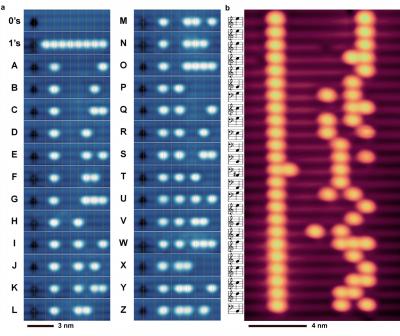
Breakthrough in Rewritable Memory by University of Alberta

To demonstrate the new discovery, Achal, Wolkow, and their fellow scientists not only fabricated the world's smallest maple leaf, they also encoded the entire alphabet at a density of 138 terabytes, roughly equivalent to writing 350,000 letters across a grain of rice. For a playful twist, Achal also encoded music as an atom-sized song, the first 24 notes of which will make any video-game player of the 80s and 90s nostalgic for yesteryear but excited for the future of technology and society.
Credit: Roshan Achal / courtesy Nature Communications
Scientists at the University of Alberta in Edmonton, Canada have created the most dense, solid-state memory in history that could soon exceed the capabilities of current hard drives by 1,000 times.
Faced with the question of how to respond to the ever-increasing needs of our data-driven society, the answer for a team of scientists was simple: more memory, less space. Finding the way to do that, however, was anything but simple, involving years of painstaking incremental advances in atomic-scale nanotechnology.
But their new discovery for atomic-scale rewritable memory–quickly removing or replacing single atoms–allows the creation of small, stable, dense memory at the atomic-scale.
“Essentially, you can take all 45 million songs on iTunes and store them on the surface of one quarter,” said Roshan Achal, PhD student in Department of Physics at the University of Alberta and lead author on the new research. “Five years ago, this wasn't even something we thought possible.”
Previous discoveries were stable only at cryogenic conditions, meaning this new finding puts society light years closer to meeting the need for more storage for the current and continued deluge of data. One of the most exciting features of this memory is that it's road-ready for real-world temperatures, as it can withstand normal use and transportation beyond the lab.
“What is often overlooked in the nanofabrication business is actual transportation to an end user, that simply was not possible until now given temperature restrictions,” continued Achal. “Our memory is stable well above room temperature and precise down to the atom.”
Achal explained that immediate applications will be data archival. Next steps will be increasing readout and writing speeds, meaning even more flexible applications.
More memory, less space
Achal works with University of Alberta physics professor Robert Wolkow, a pioneer in the field of atomic-scale physics. Wolkow perfected the art of the science behind nanotip technology, which, thanks to Wolkow and his team's continued work, has now reached a tipping point, meaning scaling up atomic-scale manufacturing for commercialization.
“With this last piece of the puzzle now in-hand, atom-scale fabrication will become a commercial reality in the very near future,” said Wolkow. Wolkow's Spin-off company, Quantum Silicon Inc., is hard at work on commercializing atom-scale fabrication for use in all areas of the technology sector.
To demonstrate the new discovery, Achal, Wolkow, and their fellow scientists not only fabricated the world's smallest maple leaf, they also encoded the entire alphabet at a density of 138 terabytes, roughly equivalent to writing 350,000 letters across a grain of rice. For a playful twist, Achal also encoded music as an atom-sized song, the first 24 notes of which will make any video-game player of the 80s and 90s nostalgic for yesteryear but excited for the future of technology and society.
###
The boundary-pushing research–“Lithography for robust and editable atomic-scale silicon devices and memories” (doi:10.1038/s41467-018-05171-y)–appears in the current issue of Nature Communications.
Media Contact
Jennifer Pascoe
jennifer.pascoe@ualberta.ca
780-660-7027












